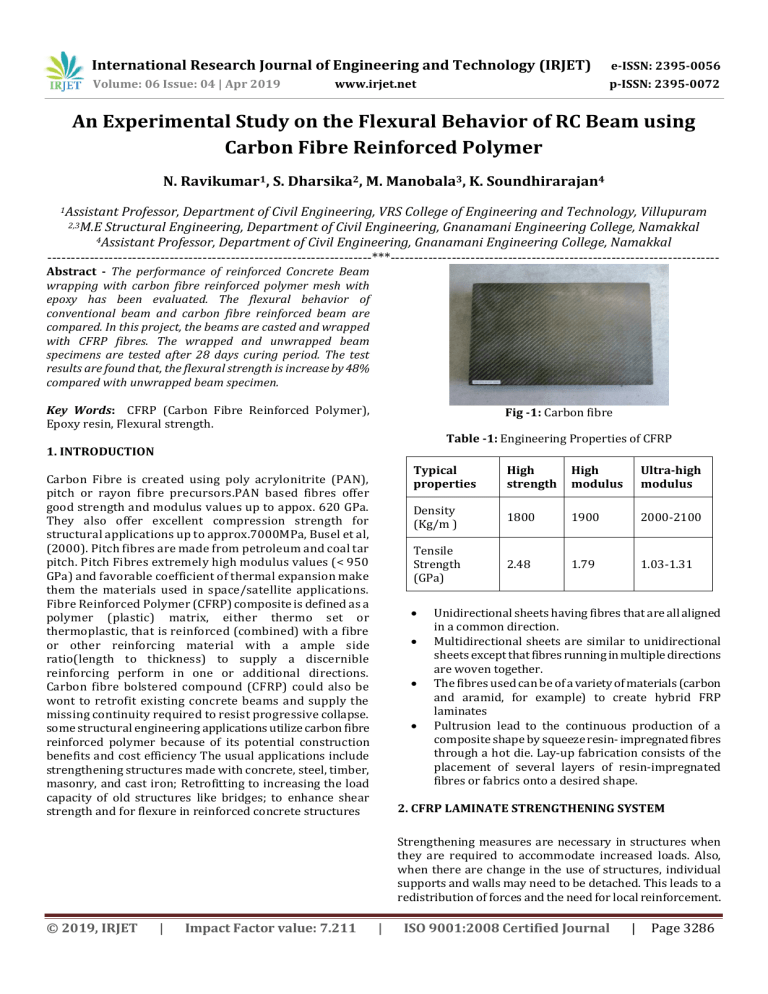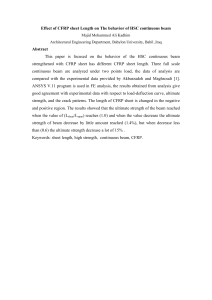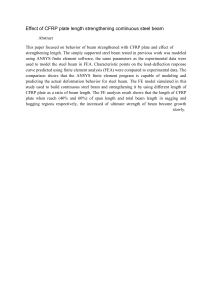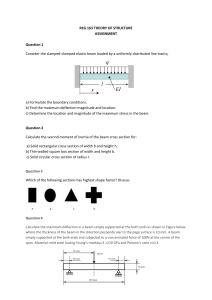IRJET- An Experimental Study on the Flexural Behavior of RC Beam using Carbon Fibre Reinforced Polymer
advertisement

International Research Journal of Engineering and Technology (IRJET) e-ISSN: 2395-0056 Volume: 06 Issue: 04 | Apr 2019 p-ISSN: 2395-0072 www.irjet.net An Experimental Study on the Flexural Behavior of RC Beam using Carbon Fibre Reinforced Polymer N. Ravikumar1, S. Dharsika2, M. Manobala3, K. Soundhirarajan4 1Assistant Professor, Department of Civil Engineering, VRS College of Engineering and Technology, Villupuram Structural Engineering, Department of Civil Engineering, Gnanamani Engineering College, Namakkal 4Assistant Professor, Department of Civil Engineering, Gnanamani Engineering College, Namakkal ---------------------------------------------------------------------***---------------------------------------------------------------------2,3M.E Abstract - The performance of reinforced Concrete Beam wrapping with carbon fibre reinforced polymer mesh with epoxy has been evaluated. The flexural behavior of conventional beam and carbon fibre reinforced beam are compared. In this project, the beams are casted and wrapped with CFRP fibres. The wrapped and unwrapped beam specimens are tested after 28 days curing period. The test results are found that, the flexural strength is increase by 48% compared with unwrapped beam specimen. Key Words: CFRP (Carbon Fibre Reinforced Polymer), Epoxy resin, Flexural strength. Fig -1: Carbon fibre Table -1: Engineering Properties of CFRP 1. INTRODUCTION Carbon Fibre is created using poly acrylonitrite (PAN), pitch or rayon fibre precursors.PAN based fibres offer good strength and modulus values up to appox. 620 GPa. They also offer excellent compression strength for structural applications up to approx.7000MPa, Busel et al, (2000). Pitch fibres are made from petroleum and coal tar pitch. Pitch Fibres extremely high modulus values (< 950 GPa) and favorable coefficient of thermal expansion make them the materials used in space/satellite applications. Fibre Reinforced Polymer (CFRP) composite is defined as a polymer (plastic) matrix, either thermo set or thermoplastic, that is reinforced (combined) with a fibre or other reinforcing material with a ample side ratio(length to thickness) to supply a discernible reinforcing perform in one or additional directions. Carbon fibre bolstered compound (CFRP) could also be wont to retrofit existing concrete beams and supply the missing continuity required to resist progressive collapse. some structural engineering applications utilize carbon fibre reinforced polymer because of its potential construction benefits and cost efficiency The usual applications include strengthening structures made with concrete, steel, timber, masonry, and cast iron; Retrofitting to increasing the load capacity of old structures like bridges; to enhance shear strength and for flexure in reinforced concrete structures Typical properties High strength High modulus Ultra-high modulus Density (Kg/m ) 1800 1900 2000-2100 Tensile Strength (GPa) 2.48 1.79 1.03-1.31 Unidirectional sheets having fibres that are all aligned in a common direction. Multidirectional sheets are similar to unidirectional sheets except that fibres running in multiple directions are woven together. The fibres used can be of a variety of materials (carbon and aramid, for example) to create hybrid FRP laminates Pultrusion lead to the continuous production of a composite shape by squeeze resin- impregnated fibres through a hot die. Lay-up fabrication consists of the placement of several layers of resin-impregnated fibres or fabrics onto a desired shape. 2. CFRP LAMINATE STRENGTHENING SYSTEM Strengthening measures are necessary in structures when they are required to accommodate increased loads. Also, when there are change in the use of structures, individual supports and walls may need to be detached. This leads to a redistribution of forces and the need for local reinforcement. © 2019, IRJET | Impact Factor value: 7.211 | ISO 9001:2008 Certified Journal | Page 3286 International Research Journal of Engineering and Technology (IRJET) e-ISSN: 2395-0056 Volume: 06 Issue: 04 | Apr 2019 p-ISSN: 2395-0072 www.irjet.net In addition, structural strengthening may become necessary owing to wear and corrosion arising from normal usage or environmental factors. Concrete structures require to be strengthened for any of the following reasons: Load increases due to higher live loads, increased wheel loads, installation of heavy machinery, or vibrations. Damage to structural parts due to age of construction materials or fire damage, improvement in aptness for use due to restraint of deflections, decrease of stress in steel reinforcement and/or decrease of crack widths. Modification of structural system due to the eradication of walls/columns and/or openings cut through slabs. Errors in planning or construction due to inadequate design dimensions and/or inadequate reinforcing steel. Fig-2 : Reinforcement Of Beam 5. CASTING AND CURING OF SPECIMENS The test specimen is stored in place away from the vibration, in moist air or 90% relative humidity and the temperature 27 hours from the time of addition of water by dry ingredients. After the period, the specimen shall be marked and removed from the modulus and unless required for the test within 24 hours, immediately submerged in clean, fresh water of saturated time. 3. APPLICATION 6. TEST SETUP After application of epoxy adhesive to the concrete and CFRP laminate, place the CFRP laminate onto the adhesive coated substrate. Use a roller to press the plate into the epoxy adhesive to achieve a void free bond line thickness of between 2 - 3 mm. Remove surplus epoxy adhesive from sides of plate while adhesive is uncured. When the epoxy has cured, test for voids by tapping surface of plate with metallic object. For aesthetic purposes, the laminate may be coated with paint. The tensile strength of carbon Fibres is equal to glass Fibres while its modulus is about three to four times higher than glass or aramid. In this report, effort has been put to describe the method of implementation of CFRP strengthening works.. The loading frame is about 50 ton capacity and load applied with the help of hydraulic jack. When we apply the three point load the deflection is about left, middle and right side. The deflections are noted in the readings. The load is applied to the beam specimen at particular load the initial cracks are noted and ultimate load is noted at the final load. The cracking pattern are drawn in marker and it is easily identified. Fig-3: Test Setup for Conventional Beam 4. REINFORCEMENT DETAILS The beams are provided with HYSD 4 numbers of 10mm bars as main reinforcement and 8mm stirrups with 150 mm c/c. The experimental investigation includes casting and testing of two beams of dimension of (1200mmx120mmx150mm) and cover of 150mm.The view of longitudinal section and cross section of a typical beam specimen as shown. One beam is conventional beam and another beam is wrapped with carbon fibre mesh. © 2019, IRJET | Impact Factor value: 7.211 7. WRAPPING OF BEAM WITH CARBON FIBRE MESH When Beam is cured with 28 days and beam is wrap with carbon fibre mesh. When Epoxy resin Araldite and ardur is mixing with perfect ratio of 1:2. The resins are mixing for few minutes the resin increases the temperature. Safety precautions like gloves, glasses and to avoid the accidents. Then apply on the beam of three sides and one side is smooth surface to apply load with loading frame instrument. | ISO 9001:2008 Certified Journal | Page 3287 International Research Journal of Engineering and Technology (IRJET) e-ISSN: 2395-0056 Volume: 06 Issue: 04 | Apr 2019 p-ISSN: 2395-0072 www.irjet.net Fig-4: Test Setup for CFRP Beam 40 9.69 10.75 8.5 50 11.26 12.5 10.8 60 12.92 13.6 11.2 70 13.09 15.7 12.9 80 14.12 16.8 13.6 90 15.05 17.8 14.6 100 17.41 18.3 16.3 110 18.08 20.6 17.23 116 19.32 21.74 20.9 8.TEST PROGRAM Testing of Conventional Beam Table -2: Load VS Deflection for Conventional Beam Load in Deflection KN (mm) left Deflection (mm) middle Deflection (mm) right 10 4.3 6.21 5.37 20 6.24 8.39 7.47 30 7.32 10.76 8.48 40 9.53 12.58 10.22 50 11.82 13.63 12.54 60 13.68 15.82 14.49 63 14.89 16.77 15.23 Fig-6 : Three Point Loading Test On CFRP Beam Graph-1: Load VS Deflection for Conventional Beam Fig-5: Loading Test on Conventional Beam Testing of CFRP Beam Table- 3: Load VS Deflection for CFRP Beam Load (KN) Left (mm) Middle (mm) Right (mm) 10 3.86 4.37 3.3 20 5.42 6.64 4.2 30 7.73 8.05 6.42 © 2019, IRJET | Impact Factor value: 7.211 Graph-2: Load VS Deflection for CFRP Beam | ISO 9001:2008 Certified Journal | Page 3288 International Research Journal of Engineering and Technology (IRJET) e-ISSN: 2395-0056 Volume: 06 Issue: 04 | Apr 2019 p-ISSN: 2395-0072 www.irjet.net 9. RESULT The flexural Strength of Beam = PL/BD2 N/mm2 Ultimate load of Conventional Beam = 63 kN Flexural strength of Conventional Beam = (63x1000x1200) / (120x150x150) Flexural strength of conventional beam= 28 N/mm2 Ultimate load of CFRP Beam = 116 kN Flexural strength of CFRP Beam = (116x1000x1200) / (120x150x150) Flexural strength of CFRP Beam = 51.55 N/mm2. 10. CONCLUSION Due to high stiffness, CFRP has less deflection when compared to normal beam. The ultimate load of Carbon Fibre beam is 116kN and conventional beam is 63kN. It concludes that, the strength of CFRP beam is better than Conventional beam. Flexural strength of conventional beam is 28N/mm2 and CFRP beam is 51N/mm2. The flexural Strength of conventional beam is low and CFRP beam is high. REFERENCES [1] [2] [3] [4] [5] Al Chami G, Theriaut M, Neale KW, Creep behavior of CFRP-strengthened reinforced concrete beams. Constr Build Mater @009; 43 (2); 129-41. Badawi M, soudki K, Fatigue behavior of RC beams strengthened with NSM CFRP rods. J Compos Constr 2009; 13(5); 415-21. D’Ambrisi A, Focacci F, Lucino R, Experimental Investigation on flexural behavior of Timber beam repaired with CFRP laminates. Compos Struct 2014; 108;720-8. Garcia R, Hajirasouliha I, Pilakoutas K, Seismic Behaviour of deficient RC frames strengthened with CFRP composites. Eng Struct. 2010; 32(10); 3075-85. Soudki K, El-Salakaway E, Craig B, Behavior of CFRP strengthened reinforced concrete beams in corrosive environment, J Comppos Constr 2007; 11(3); 291-8. © 2019, IRJET | Impact Factor value: 7.211 | ISO 9001:2008 Certified Journal | Page 3289






